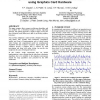Free Online Productivity Tools
i2Speak
i2Symbol
i2OCR
iTex2Img
iWeb2Print
iWeb2Shot
i2Type
iPdf2Split
iPdf2Merge
i2Bopomofo
i2Arabic
i2Style
i2Image
i2PDF
iLatex2Rtf
Sci2ools
104
click to vote
GECCO
2008
Springer
2008
Springer
Rapid evaluation and evolution of neural models using graphics card hardware
This paper compares three common evolutionary algorithms and our modified GA, a Distributed Adaptive Genetic Algorithm (DAGA). The optimal approach is sought to adapt, in near realtime, biological model behaviour to that of real biology within a laboratory. Near real-time adaptation is achieved with a Graphics Processing Unit (GPU). This, together with evolutionary computation, enables new forms of experimentation such as online testing, where biology and computational model are simultaneously stimulated and their responses compared. Rapid analysis and validation provide a platform that is required for rapid prototyping, and along with online testing, can provide new insight into the cause of biological behaviour. In this context, results demonstrate that our DAGA implementation is more efficient than the other three evolutionary algorithms due to its suitability to the adaptation environment, namely the large population sizes promoted by the GPU architecture. Categories and Subject D...
Biological Model Behaviour | Common Evolutionary Algorithms | Evolutionary Algorithms | GECCO 2008 | Optimization |
Related Content
| Added | 09 Nov 2010 |
| Updated | 09 Nov 2010 |
| Type | Conference |
| Year | 2008 |
| Where | GECCO |
| Authors | Thomas F. Clayton, Leena N. Patel, Gareth Leng, Alan F. Murray, Iain A. B. Lindsay |
Comments (0)

